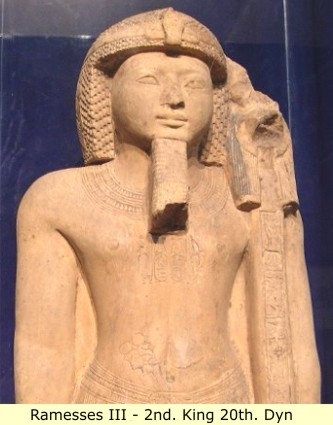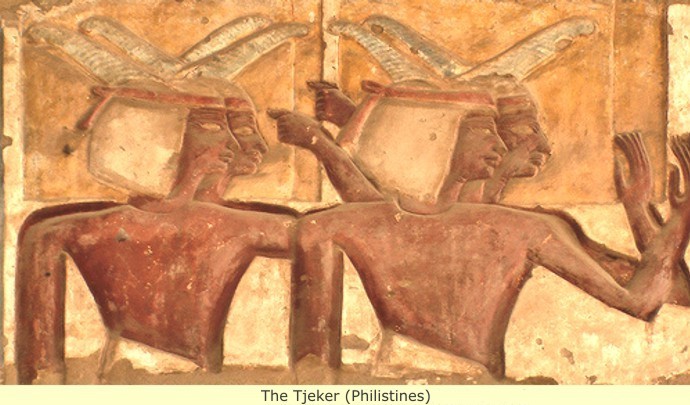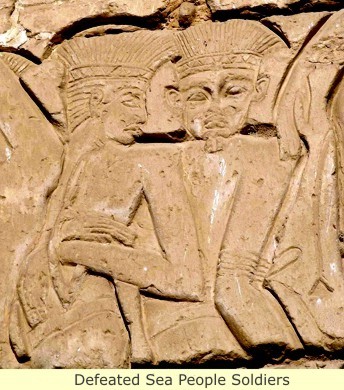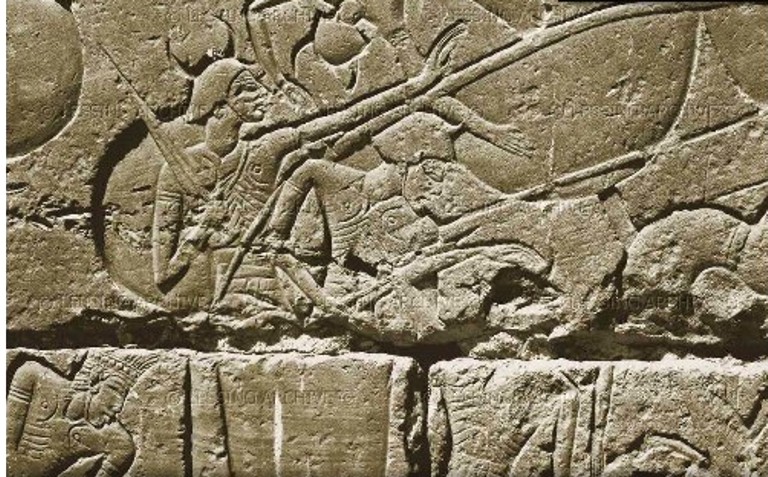[The AMAIC would argue somewhat lower BC dates than below for Era of Ramses III]
Medinet Habu is a mortuary temple that was constructed for Ramesess III at Thebes in Upper Egypt. The temple decoration consists of a series of reliefs and texts telling of the many exploits of the king, from his campaign against the Libyans to, most importantly, his war against the Sea Peoples.
 |
 The texts and reliefs that deal with the Sea Peoples date to year eight of Ramesess III’s reign, approximately 1190 B.C. The significance of these texts is that they provide an account of Egypt’s campaign against the “coalition of the sea” from an Egyptian point of view.
The texts and reliefs that deal with the Sea Peoples date to year eight of Ramesess III’s reign, approximately 1190 B.C. The significance of these texts is that they provide an account of Egypt’s campaign against the “coalition of the sea” from an Egyptian point of view.The Medinet Habu inscriptions are also significant for their artistic depictions of the Sea Peoples. These provide valuable information about the appearance and accoutrements of the various groups, and can lend clues towards deciphering their ethnic backgrounds (Redford 1992: 251).
But this was not the first attempted invasion by the Sea Peoples, the first attempt was against king Merneptah (reign:1213 to 1203 B.C.). His victory was recorded on his stele: Click here >>>
LIBYANS
 |
 |  |
The Sea People
The Peleset and Tjeker (Minoans) of Crete, they would later be known as the “Philistines” after they had settled in Southern Canaan. Over time, this area became known by a form of their name “Palestine”. The Lukka who may have come from the Lycian region of Anatolia, The Ekwesh and Denen who seem to be identified with the original (Black) Greeks, The Shardana (Sherden) who may be associated with Sardinia, The Teresh (Tursha or Tyrshenoi), the Tyrrhenians - the Greek name for the Etruscans, and The Shekelesh (Sicilians?).From the textual evidence on the temple walls, it appears that the Peleset and the Tjeker made up the majority of the Sea Peoples involved in the year 8 invasion. In the artistic depictions, both types are depicted wearing a fillet (a ribbon used as a headband), from which protrudes a floppy plume and a protective piece down the nape of the neck.
 |
 |
Their armament included long swords, spears and circular shields, and they are occasionally shown wearing body armor. Other groups, such as the Shekelesh and Teresh, are shown wearing cloth headdresses and a medallion upon their breasts. The weaponry that they carried consisted of two spears and a simple round shield. The Shardana soldiers are most obviously armored in the artistic depictions, due to the thick horned helmets that adorn their heads (Redford 1992: 252).
 |
The land battle and sea battle scenes provide a wealth of information on the military styles of the Sea Peoples. The reliefs depicting the land battle show Egyptian troops, chariots and auxiliaries fighting the enemy, who also used chariots, very similar in design to Egyptian chariots. Although the chariots used by the Sea Peoples are very similar to those used by the Egyptians, both being pulled by two horses and using wheels with six spokes, the Sea Peoples had three soldiers per chariot, whereas the Egyptians only had one, or occasionally two.
 |

The land battle scenes also give the observer some sense of the Sea Peoples’ military organization. According to the artistic representations, the Philistine warriors were each armed with a pair of long spears, and their infantry was divided into small groups consisting of four men each. Three of those men carried long, straight swords and spears, while the fourth man only carried a sword. The relief depicting the land battle is a massive jumble of figures and very chaotic in appearance, but this was probably a stylistic convention employed by the Egyptians to convey a sense of chaos. Other evidence suggests that the Sea Peoples had a high level of organization and military strategy (O’Conner 2000: 95).
 |
A striking feature of the land battle scene is the imagery of ox-pulled carts carrying women and children in the midst of a battle. These carts seem to represent a people on the move (Sandars 1985: 120).
The other famous relief at Medinet Habu regarding the Sea Peoples is of the sea battle. This scene is also shown in a disorganized mass, but as was mentioned earlier, was meant to represent chaos, again contradicting the Egyptians’ descriptions of the military success and organization of the Sea Peoples. The sea battle scene is valuable for its depictions of the Sea Peoples' ships and their armaments.
 |
 |
 |
The Egyptians and the Sea Peoples both used sails as their main means of naval locomotion. However, interestingly, the Sea Peoples' ships appear to have no oars, which could indicate new navigation techniques (Dothan 1982: 7). Another interesting feature of the Sea Peoples' ships is that all the prows are carved in the shape of bird heads, which has caused many scholars to speculate an Aegean origin for these groups. Wachsmann (2000) speculates that the sea battle relief shows the battle in progression, from beginning to end.
....
Taken from: http://realhistoryww.com/world_history/ancient/Misc/Medinet_Habu/Medinet_Habu.htm

No comments:
Post a Comment